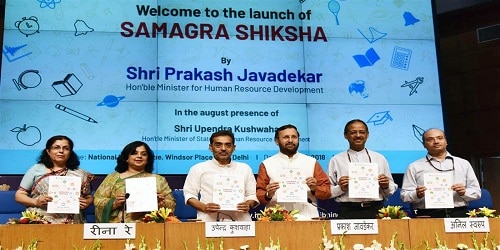The scheme was launched on 25th July 2015 in Patna for the first time by Shri NArendra Modi. Similar scheme exists in Gujarat and was launched when Mr Modi was the CM of the state.
The Pandit Deen Dayal Upadyay Gram Jyothi Yojana aims at supplying power to all. It was launched under the Minister of Power as a flagship program.
What is a Flagship Program?
A Flagship Program is a scheme approved by the Union of Cabinet. The guidelines and working functionalities of the Flagship programs can be controlled by the Development Evaluation Advisory Committee of the Planning Commission.
Key Features of the PDDUGJY
- Segregation of feeders (Rural households and the agriculture)
- Strengthening sub – transmission
- Distribution Infrastructure including metering at all rural households.
RGGVY and PDDUGJY
The scheme replaces RGGVY – Rajiv Gandhi Grameen VidyutiKaran Yojana. Therefore, it also includes the pending project of the scheme. PDDUGJY has to look after the unfinished parts like
- Micro – Grid Networks
- Off – Grid Networks
- Rural electrification projects for which the amount has been sanctioned.
Why is the scheme needed?
The scheme focuses on providing uninterrupted power supply to rural areas. Hence there is shortage of power supply in the country’s rural regime.
Rural India is fed by the local distribution system. And during the peak time of power demand the authorities are forced to resort (alternate way) to load shedding. Load shedding is cutting the power supply to certain areas in order to protect the system. When the power drawn from the system exceeds its capability value, it breaks down. Hence, load shedding is resorted.
Implementing the scheme will prevent load shedding.
How far is the scheme helpful?
Many Agriculture intensive states like Bihar would be absolutely benefitted from the scheme. Thousands of Kilometres of new lines are to be laid. The scheme also aims at constructing new sub stations.
Benefits of the scheme
- Rural Households shall be electrified.
- Agricultural yield will be increased
- Development in Health, Banking and Education.
- Better social security at nights due to lights.
- Increased growth in small and household enterprises as there would be continuous supply of power.
Analysis of the DDUGJY
Feeder separation
What is Feeder Seperation?
Feeder is the core of distribution of power supply. All the power lines from rural to the cities are connected to the feeder in a city. Hence, when there is a high power demand, feeders are over loaded and leads to load shedding.
Why is Feeder Seperation important?
Feeder separation is allocating a separate feeder for the rural households and agriculture. This will remove the burdening of overload on a single feeder and will lead to continuous supply of power. Hence feeder separation is very important especially in rural regime to supply uninterrupted supply of power.
Govt other similar initiatives
- 1974 – Rural Electrification – Minimum Needs Program
- 1988 – Single point light to rural families – Kutir Jyoti Yojana
- 2000 – Electrifying un – electrified villages – Pradhan Mantri Gramodaya Yojana
- 2001 – Electrifying villages not connected to the grid – Remote Village Electrification
- 2003 – AcceleratedRural Electrification Programme
- 2004 – Accelerated electrification of one lakh villages and one crore households.
- 2005 – RGGVY – at least 1unit/household/day.
- 2014 – DDUGJY
The way forward
- As we see there are different schemes focussing on the same goal. The schemes should be integrated
- A regulatory framework has to be set up to monitor the integrated scheme.
- More Solar energy implementations have to be brought in. This will reduce the vulnerable losses due to accidents and calamities. As rural areas become the last to be addressed on priority basis.
- The first solar street light was introduced in 1980 in RURAL India. But till today there are many other rural households still unaware of solar energy.
- Mini grids with variety of sizes as those installed in Gujarat have to be globalised. These mini grids get supply from solar, small hydro, wind or biomass.
Major policies of Rural Electrification program
The Electricity Act, 2003
The act involves generation, transmission and distribution of power. It centralised the operation of all the electricity boards under a single regulatory body. It established an Apellate tribunal for the power disputes.
What is an appellate tribunal? – Tribunals function like a court. They were set up to save time. Once a case is transferred by a court or a legal body or by the government to a tribunal, the court has no say in the judgement of the tribunal.
National Electricity Policy, 2005
The Government decides on its Electricity Policy since this step. It targets on the areas that requires immediate priority and frames a policy for the current year.
This year the Government has launched a National Electricity plan for 2017 -22. Click here to know more about the plan.
Like the National Electrification policy the following are also revised every year
- Rural Electrification Policy, 2006
- National Tariff Policy, 2006
Conclusion
The scheme aims at bringing electricity to every door step. It however needs a full fledged implementation as per the deadline. If so it would be a great step in developing other schemes of the government like Make in India, Rural employment programmes,etc.
Quiz on DDUGJY – Test yourself
- When was DDUGJY launched?
- Which existing scheme did the DDUGJY replace?
- What are the three main key features of the scheme?
- Who launched DDUGJY?
- Name two electrification policies of the 21st century.
- What are Flagship program? Is DDUGJY a flagship program?
References
- http://www.ddugjy.gov.in/mis/portal/index.jsp
- http://pib.nic.in/newsite/PrintRelease.aspx?relid=123595





